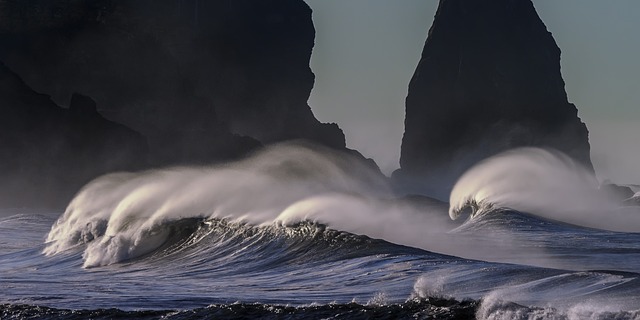The Pacific Ocean is the largest of the Earth’s oceanic divisions. It extends from the Arctic Ocean in the north to the Southern Ocean (or, depending on definition, to Antarctica) in the south and is bounded by Asia and Australiain the west and the Americas in the east.
At 165.25 million square kilometers (63.8 million square miles) in area, this largest division of the World Ocean—and, in turn, the hydrosphere—covers about 46% of the Earth’s water surface and about one-third of its total surface area, making it larger than all of the Earth’s land area combined.[1]
The equator subdivides it into the North Pacific Ocean and South Pacific Ocean, with two exceptions: theGalápagos and Gilbert Islands, while straddling the equator, are deemed wholly within the South Pacific.[2] TheMariana Trench in the western North Pacific is the deepest point in the world, reaching a depth of 10,911 metres (35,797 ft).[3]
Though the peoples of Asia and Oceania have travelled the Pacific Ocean since prehistoric times, the eastern Pacific was first sighted by Europeans in the early 16th century when Spanish explorer Vasco Núñez de Balboacrossed the Isthmus of Panama in 1513 and discovered the great “southern sea” which he named Mar del Sur. The ocean’s current name was coined by Portuguese explorer Ferdinand Magellan during the Spanishcircumnavigation of the world in 1521, as he encountered favourable winds on reaching the ocean. He called itMar Pacifico, which in both Portuguese and Spanish means “peaceful sea”
 Facts and Figures
Facts and Figures
Geography
Climate
Water
Pacific Ocean Currents
pacific ocean fish
where is pacific ocean located
how deep is the pacific ocean
- The mighty Pacific is the largest ocean on our planet
- It covers 65,436,200 square miles (169,479,000 square kilometres), which is 30% of the planet’s entire surface area (larger than all the land on earth, combined)
- Average depth 4,188 metres (14,000 feet)
- It extends from the Arctic down to the Antarctic and from Australiaand Asia across to the Americas
The Pacific basin is surrounded by volcanoes and earthquake zones (called the Ring of Fire). About 80% of the world’s earthquakes take place in this area.
The largest coral reef in the world, the Great Barrier Reef, lies in the Pacific Ocean just off the coast of Australia. Also, there are approximately 25,000 islands in the Pacific, many more than in any other ocean.


Leave a Reply